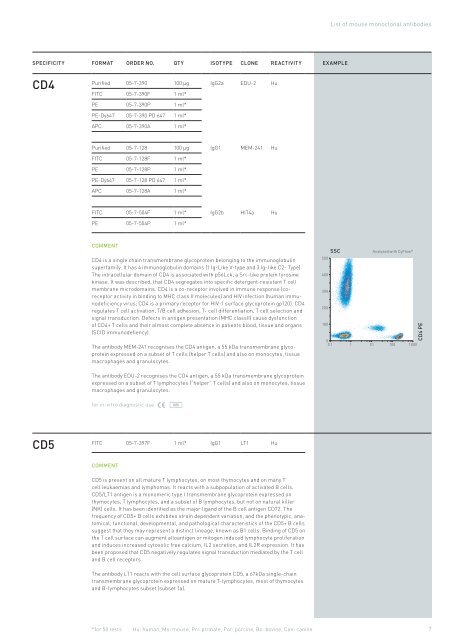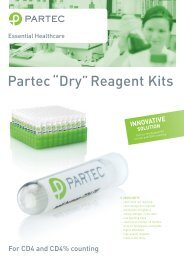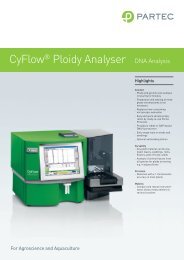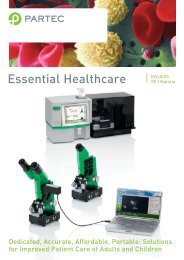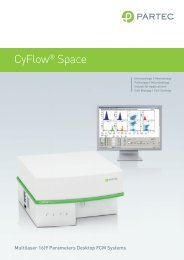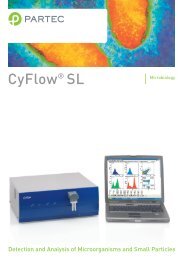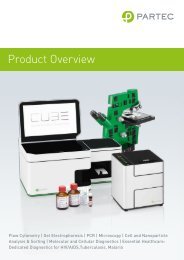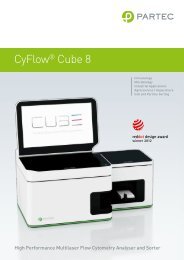Partec Reagents & mAb Catalog
Partec Reagents & mAb Catalog
Partec Reagents & mAb Catalog
Create successful ePaper yourself
Turn your PDF publications into a flip-book with our unique Google optimized e-Paper software.
sPecificity format order no. Qty isotyPe clone reactivity examPle<br />
cd4 Purified 05-7-390 100 µg IgG2a EDU-2 Hu<br />
FITC 05-7-390F 1 ml*<br />
PE 05-7-390P 1 ml*<br />
PE-Dy647 05-7-390 PD 647 1 ml*<br />
APC 05-7-390A 1 ml*<br />
Purified 05-7-128 100 µg IgG1 MEM-241 Hu<br />
FITC 05-7-128F 1 ml*<br />
PE 05-7-128P 1 ml*<br />
PE-Dy647 05-7-128 PD 647 1 ml*<br />
APC 05-7-128A 1 ml*<br />
FITC 05-7-504F 1 ml* IgG2b HIT4a Hu<br />
PE 05-7-504P 1 ml*<br />
comment<br />
CD4 is a single chain transmembrane glycoprotein belonging to the immunoglobulin<br />
superfamily. It has 4 immunoglobulin domains (1 Ig-Like V-type and 3 Ig-like C2- Type).<br />
The intracellular domain of CD4 is associated with p56Lck, a Src-like protein tyrosine<br />
kinase. It was described, that CD4 segregates into specific detergent-resistant T cell<br />
membrane microdomains. CD4 is a co-receptor involved in immune response (coreceptor<br />
activity in binding to MHC class II molecules) and HIV infection (human immunodeficiency<br />
virus; CD4 is a primary receptor for HIV-1 surface glycoprotein gp120). CD4<br />
regulates T cell activation, T/B cell adhesion, T- cell differentiation, T cell selection and<br />
signal transduction. Defects in antigen presentation (MHC classII) cause dysfunction<br />
of CD4+ T cells and their almost complete absence in patients blood, tissue and organs<br />
(SCID immunodefiency).<br />
The antibody MEM-241 recognises the CD4 antigen, a 55 kDa transmembrane glycoprotein<br />
expressed on a subset of T cells (helper T cells) and also on monocytes, tissue<br />
macrophages and granulocytes.<br />
The antibody EDU-2 recognises the CD4 antigen, a 55 kDa transmembrane glycoprotein<br />
expressed on a subset of T lymphocytes (“helper” T cells) and also on monocytes, tissue<br />
macrophages and granulocytes.<br />
for in-vitro diagnostic use<br />
cd5 FITC 05-7-397F 1 ml* IgG1 LT1 Hu<br />
comment<br />
CD5 is present on all mature T lymphocytes, on most thymocytes and on many T<br />
cell leukaemias and lymphomas. It reacts with a subpopulation of activated B cells.<br />
CD5/LT1 antigen is a monomeric type I transmembrane glycoprotein expressed on<br />
thymocytes, T lymphocytes, and a subset of B lymphocytes, but not on natural killer<br />
(NK) cells. It has been identified as the major ligand of the B cell antigen CD72. The<br />
frequency of CD5+ B cells exhibites strain dependent variation, and the phenotypic, anatomical,<br />
functional, developmental, and pathological characteristics of the CD5+ B cells<br />
suggest that they may represent a distinct lineage, known as B1 cells. Binding of CD5 on<br />
the T cell surface can augment alloantigen or mitogen induced lymphocyte proliferation<br />
and induces increased cytosolic free calcium, IL2 secretion, and IL2R expression. It has<br />
been proposed that CD5 negatively regulates signal transduction mediated by the T cell<br />
and B cell receptors.<br />
The antibody LT1 reacts with the cell surface glycoprotein CD5, a 67kDa single-chain<br />
transmembrane glycoprotein expressed on mature T-lymphocytes, most of thymocytes<br />
and B-lymphocytes subset (subset 1a).<br />
*for 50 tests<br />
Hu: human, Ms: mouse, Pri: primate, Por: porcine, Bo: bovine, Can: canine<br />
500<br />
400<br />
300<br />
200<br />
100<br />
List of mouse monoclonal antibodies<br />
ssc Analysed with CyFlow ®<br />
Pe cd4<br />
0<br />
0.1 1 10 100 1000<br />
7


